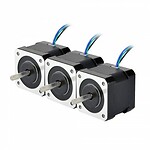Will hybrid stepper motors become mainstream in the future?
21 augustus 2023 - San Bernardino County, Verenigde Staten
Hybrid stepper motor is a stepper motor designed by combining the advantages of permanent magnet and reactive. It is divided into two phases, three phases, and five phases. The step angle of the two phases is generally 1.8 degrees, the step angle of the three phases is generally 1.2 degrees, and the step angle of the five phases is generally 0.72 degrees.
The rotor of ahybrid stepper motor itself has magnetism, so the torque generated under the same stator current is greater than that of a reactive stepper motor, and its step angle is usually small. Therefore, economic CNC machine tools generally need to be driven by a hybrid stepper motor. However, the hybrid rotor has a complex structure and a large rotor inertia, which results in lower speed than reactive stepper motors.
The original model of a stepper motor originated in the late 1990s from 1830 to 1860. With the development of permanent magnet materials and semiconductor technology, stepper motors quickly developed and matured.
In the late 1960s, China began researching and manufacturing stepper motors. From then until the late 1960s, a small number of products were mainly developed by universities and research institutes for the research of certain devices. Starting from the early 1970s, breakthroughs were made in production and research. From the mid-1970s to the mid-1980s, it entered a stage of development, and various high-performance products were continuously developed. After the mid-1980s, due to the development and research of hybrid stepper motors, the technology of hybrid stepper motors in China, including body technology and drive technology, gradually approached the level of foreign industries. The application of various hybrid stepper motors and their drivers gradually increased.
Future development direction of stepper motors:
1. The stepper motor will move to a closed loop stepper motor , integrating with the driver and servo system for integrated development. In the future, stepper motors will have smaller volumes, superior functions, and higher cost-effectiveness, and will be widely used in civilian equipment such as home robots and intelligent devices.
2. Continue to develop in the direction of miniaturization.
3. Change the circular motor to a square motor. Due to the square structure of the motor, it is possible to design the rotor larger than a circular one, resulting in a significant increase in its torque to volume ratio.

